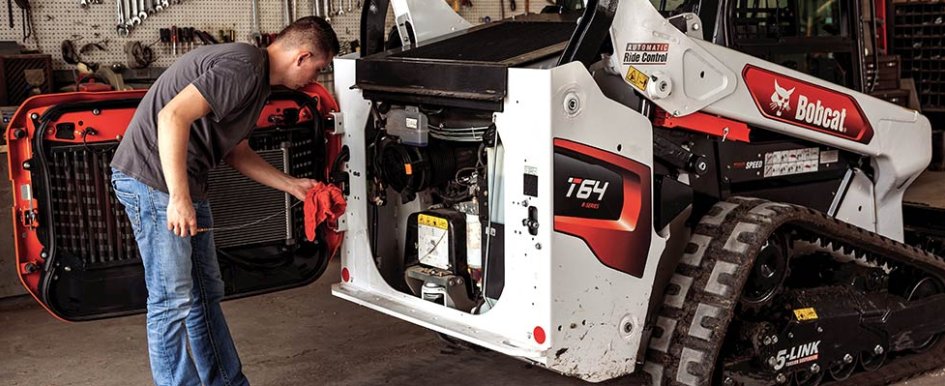
Spring is a great time to get your equipment ready for the busy working season ahead. With longer days, comfortable temperatures and improved ground conditions, it’s the perfect opportunity to make sure your equipment is in top shape.
The best way to ensure your loaders are ready to go is to adhere to an ongoing preventive maintenance checklist for all your equipment, including your loaders. Using your operation and maintenance manual, you can follow guidelines for how often to service your machine. By doing so, you can help minimize downtime. It also helps you take a more managed approach to dealing with any significant repair work that may be required due to wear-and-tear in advance of your busy season.
Consider the following steps as you inspect and prepare your loader(s) for a productive season ahead.
Check the Battery
Whether your machine has been idle since last fall or has been operating throughout the winter, it’s important to make sure your battery is fully charged and the connections are clean. Terminals that are corroded can lead to both starting and charging issues. Some batteries will slowly run down and need charging before operation unless you have done regular maintenance or disconnected them during periods of inactivity. In colder climates, a loader’s battery can freeze if it has a low charge. This may lead to internal damage in the battery, so keeping your battery charged and terminals clean year-round can help prevent any issues when you need the most out of your machine.
Check Your Tires or Tracks
Whether your machine has tires or tracks, reviewing their condition is a critical element to the efficiency of your machine’s operation. For example, any kind of tire — automobile, truck, bicycle, etc. — that has been inactive for quite some time will lose air pressure and need inspection (and maintenance) before use. The tires on a loader are no different, so making sure they are inflated to the manufacturer-recommended pressure shown on the sidewall of the tire is important. Likewise, if you have a compact track loader or mini track loader, be sure to inspect your tracks, as you want to look for excessive or uneven wear and ensure the proper tension exists before using the machine. You can also refer to your manual for any questions regarding the proper inflation pressure for skid-steer loader tires or track tensioning for compact track loaders and mini track loaders.
Check Your Cooling System
As spring transitions to summer, working in hotter temperatures becomes the norm. Ensuring your equipment’s cooling system is working properly is important, as you do not want it to work any harder than necessary and risk damage to the engine due to overheating. You can use an air compressor to blow out any dust or debris that have accumulated in the radiator and other cooling components. If necessary, flush the entire system and fill it with fresh fluids. Refer to your manual for recommendations on how often this should be done as a part of your regular maintenance and upkeep.
Check Filters, Fluids & Belts
The efficient operation of any engine requires a lot of different elements working together, which is why it is important to regularly monitor your fuel, engine oil, hydraulic fluid, coolant, grease and drive motor lubricants. To minimize potential downtime, you must also make sure the fluids and fuel being used match the proper ambient temperatures, as well as manufacturer’s recommendations for your particular machine. Changing filters is recommended annually at the minimum. The number of hours the machine is in use and in what type of environment the work is being done may require more frequent replacement. Dirtier and dustier conditions necessitate more frequent changes of filters, because a dirty or clogged filter can not only compromise sensitive components, but also negatively impact your machine’s performance.
Likewise, belts and hoses should be checked for discoloration or wear. Checking for signs of possible leaks around seals, oil leaks, loose bolts, etc., is also important. In short, get in the habit of checking and changing all filters on a regular basis as a part of ongoing maintenance plans, as well as closely monitoring for leaks, loose parts and other wear that could impact the operation of your machine if not properly addressed.
Do Not Forget Your Attachments
Your attachments are just as important as your machine, so ensuring they are ready for the day-to-day tasks they are expected to perform is critical. Taking the time to check attachment hoses, cylinders and guards, cutting blades and edges to determine if damage or wear has occurred is a good practice. Essentially, anything that engages with the ground, including cutting edges and bucket teeth, should be thoroughly inspected before use. Test them and make sure the buildup of pressure is occurring properly. Checking attachment performance in the spring will help ensure everything is in top working condition when the work season starts.
Key Takeaway
While not a complete list of all the maintenance and upkeep considerations for a loader, these tips present a good basis from which to start prior to any busy season. By performing appropriate preventive maintenance, you can extend the life of your machine and minimize project delays due to unscheduled downtime.



